zepto 对象思想与源码分析
原型对象
Array.prototype
每一个函数,都有一个 prototype 属性,不管是你自定义的,还是函数内置的。
1
2
3
| var fn = function() {};
console.log(fn.prototype);
console.log(fn.prototype.constructor === fn);
|
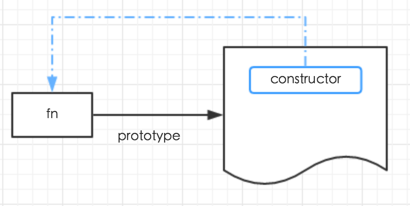
这里的 fn.prototype 打印出一个对象,对象里的 constructor 属性又指回了该函数本身 fn。
即每一个原型对象都有一个 consctructor 属性指向关联的构造函数,比如:
1
| Array.prototype.constructor === Array;
|
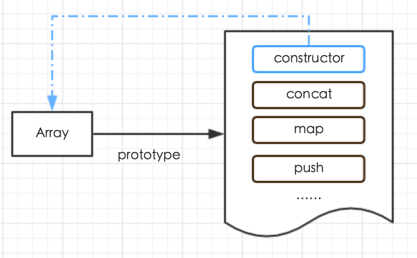
我们接着看:
1
| console.log(Array.prototype);
|
这里,除了 constructor 属性,还有其他内置的属性,即我们经常使用的操作数组的方法。
__proto__(隐式原型)
所有通过函数 new (构造函数)出来的实例对象,都有一个 __proto__属性,指向该对象的 prototype,比如:
1
2
| var arr = new Array();
arr.__proto__ === Array.prototype;
|
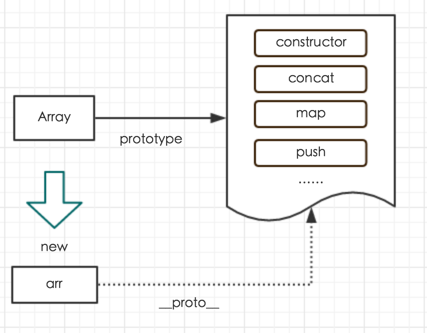
原型链:由相互关联的原型(__proto__)组成的链状结构就是原型链。
举个关于继承 extends 的例子:
1
2
3
4
5
6
7
8
9
10
11
12
13
14
15
16
| function Animal() {
this.eat = function() {
console.log("Animal eat");
};
}
function Dog() {
this.bark = function() {
console.log("Dog bark");
};
}
Dog.prototype = new Animal();
var dog = new Dog();
dog.eat();
dog.bark();
|
上面看明白了,那么 ES6 的继承我们也就可以明白原理了,即 class Dog extends Animal 相当于 Dog.prototype = new Animal()
1
2
3
4
5
6
7
8
9
10
11
12
13
14
15
16
17
18
19
20
21
| class Animal {
constructor(name) {
this.name = name;
}
eat() {
console.log("Animal eat!" + this.name);
}
}
class Dog extends Animal {
constructor(name) {
super(name);
this.name = name;
}
bark() {
console.log("Dog bark!" + this.name);
}
}
const dog = new Dog("哈士奇");
dog.eat();
dog.bark();
|
接下来,我们就清楚为什么能这样:
当我们要使用一个对象(数组)的某个功能时,如果该对象本身具有这个功能,直接调用,没有的话,那就去自身的__proto__属性中去找
1
2
3
4
5
6
7
8
9
10
| var obj = {
myfn: function() {
console.log("myfn");
}
};
obj.myfn();
obj.hasOwnProperty("myfn");
obj.toString();
obj.hasOwnProperty("toString");
obj.__proto__.hasOwnProperty("toString");
|
hasOwnProperty()就可以得出这个属性是否是属于该对象本身的属性:
- myfn 是我们自定义的,
obj.hasOwnProperty('myfn')为 true
- toString() 我们不是自定义的,却可以使用,查一下是否属于自定义属性,
obj.hasOwnProperty('toString'),答案为 false
- 既然不属于自定义属性,那就去自身的
__proto__去找,然后去原型对象上查一下,obj.__proto__.hasOwnProperty('toString'),哦,原来在这儿
在源码中,我们经常看到Array.prototype.concat,其实就是我们使用的[].concat,[],因为[].__proto__ === Array.prototype
__proto__是可修改的
比如,我们新增一个addClass()方法:
1
2
3
4
5
6
| var arr = [1, 2, 3];
arr.__proto__.addClass = function() {
console.log(123);
};
arr.push(4);
arr.addClass();
|
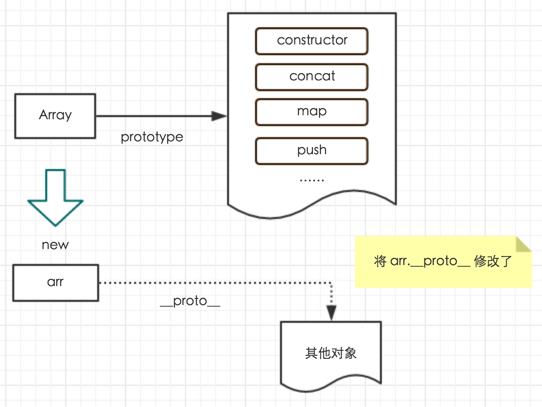
但是,这里要注意,如下重写之后,就没有了诸如 push、concat 等方法:
1
2
3
4
5
6
| arr.__proto__ = {
addClass: function() {
console.log(123);
}
};
arr.push(3);
|
Object.prototype的原型
万物皆对象,到最后依旧是对象,最后这个东东是个啥,我们来看一下:
1
2
3
4
5
6
7
8
9
10
11
12
13
14
15
16
17
18
|
function Person() {}
var myfn = new Person();
myfn.__proto__ === Person.prototype;
Person.prototype.__proto__ === Object.prototype;
Function.prototype.__proto__ === Object.prototype;
var fn = function() {};
fn.prototype.__proto__ === Object.prototype;
Object.prototype.__proto__ === null;
typeof null;
|
总结:
所有的函数都有一个 prototype属性,该属性指向了一个对象,该对象就是调用该构造函数而创建出来的实例(如 myfn)的原型(如myfn.__proto__),即:myfn.__proto__ === Person.prototype
所有的对象(除 null)都具有一个__proto__属性,该属性指向该对象的原型,比如:myfn.__proto__ === Person.prototype
原型也是一个对象,根据上条,那原型的原型,就是Object.prototype
最后的 null 对象,可以当做是 什么都没有
盗一张图,我们就更加清楚了(蓝色这条表示的是原型链)
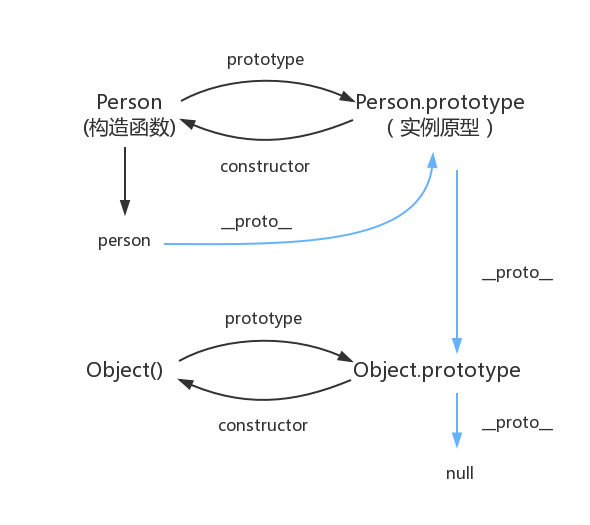
参考资料:
Zepto 对象设计
主体设计
1
2
3
4
5
6
7
8
9
10
11
12
13
14
15
16
17
18
19
20
21
22
23
24
25
26
27
28
29
30
31
32
33
34
35
36
37
38
39
40
41
| var Zepto = (function() {
var $,
zepto = {};
zepto.Z = function(dom, selector) {
dom = dom || [];
dom.__proto__ = $.fn;
dom.selector = selector || "";
return dom;
};
zepto.init = function(selector, context) {
var dom;
return zepto.Z(dom, selector);
};
$ = function(selector, context) {
return zepto.init(selector, context);
};
$.fn = {
forEach: emptyArray.forEach,
concat: function() {}
};
return $;
})();
window.Zepto = Zepto;
window.$ === undefined && (window.$ = Zepto);
|
自定义模拟
1
2
3
4
5
6
7
8
9
10
11
12
13
14
15
16
17
18
19
20
21
22
23
24
25
26
27
28
29
30
31
32
33
34
35
36
37
38
39
40
41
42
| (function(window) {
var $,
zepto = {};
function Z(dom, selector) {
var i,
len = dom.length ? dom.length : 0;
for (var i = 0; i < dom.length; i++) {
this[i] = dom[i];
}
this.length = len;
this.selector = selector || "";
}
zepto.Z = function(dom, selector) {
return new Z(dom, selector);
};
zepto.init = function(selector) {
var slice = Array.prototype.slice;
var dom = slice.call(document.querySelectorAll(selector));
return zepto.Z(dom, selector);
};
$ = function(selector) {
return zepto.init(selector);
};
$.fn = {
css: function(key, value) {
console.log("css");
},
html: function(value) {
console.log("html");
}
};
Z.prototype = $.fn;
window.$ = $;
})(window);
|
流程:$() -> zepto.init() -> zepto.Z() -> new Z() -> Z.prototype = $.fn;
最新版(v1.2.0)模拟
1
2
3
4
5
6
7
8
9
10
11
12
13
14
15
16
17
18
19
20
21
22
23
24
25
26
27
28
29
30
31
32
33
34
35
36
37
38
39
40
41
42
43
44
45
46
47
48
49
50
51
52
53
54
55
56
57
58
59
60
61
62
63
64
65
66
67
68
69
70
71
72
73
74
75
76
77
78
79
80
81
|
(function(global, factory) {
if (typeof define === "function" && define.amd) {
define(function() {
return factory(global);
});
} else {
factory(global);
}
})(this, function(window) {
var Zepto = (function() {
var $;
var zepto = {};
function Z(dom, selector) {
var i,
len = dom ? dom.length : 0;
for (i = 0; i < len; i++) this[i] = dom[i];
this.length = len;
this.selector = selector || "";
}
zepto.Z = function(dom, selector) {
return new Z(dom, selector);
};
zepto.init = function(selector, context) {
var slice = Array.prototype.slice;
var dom = slice.call(document.querySelectorAll(selector));
return zepto.Z(dom, selector);
};
$ = function(selector, context) {
return zepto.init(selector, context);
};
$.fn = {
constructor: zepto.Z, // 手动绑定 constructor 属性
length: 0,
push: "push method",
css: function() {
console.log("css");
return this;
},
html: function() {
console.log("html")
return this;
}
};
$.fn.on = function(event, data, callback) {
console.log("on method");
};
$.fn.off = function(event, data, callback) {
console.log("off method");
};
$.fn.bind = function(event, data, callback) {
return this.on(event, data, callback);
};
$.fn.unbind = function(event, callback) {
return this.off(event, callback);
};
zepto.Z.prototype = Z.prototype = $.fn;
$.zepto = zepto;
return $;
})();
window.Zepto = Zepto;
window.$ === undefined && (window.$ = Zepto);
});
|
amd 规范:
1
2
3
4
5
6
7
8
9
| (function(global, factory) {
if (typeof define === "function" && define.amd) {
define(function() {
return factory(global);
});
} else {
factory(global);
}
})(this, function(window) {})
|
学习资料







